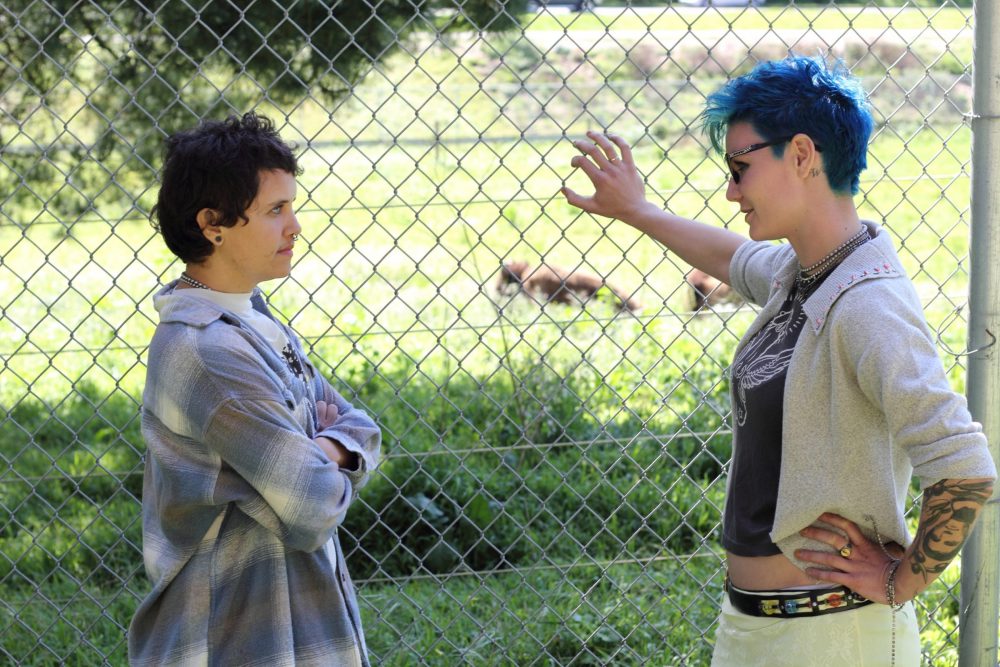We interview all 20 directors of the film adaptation of Michelle Tea’s ‘Valencia.’
Michelle Tea comes to Frameline (San Francisco’s annual LGBT film festival) this Friday with one movie that is many: an adaptation of her seminal memoir Valencia by not one, not two, but 20 different prominent queer directors. Valencia the movie consists of 18 short films based on individual chapters from the book, all edited together into a feature. How do 20 people collaborate on the same movie? To find out, we asked all of them.
Why did you think Valencia would make a good film?
Jerry Lee: It’s an amazing historical document about 90s San Francisco lifestyles, and the movie will show that to people who have no idea what it was like living in the Mission then.
Sharon Barnes: What it does with genre is interesting: It’s a memoir, so it’s gritty, but it really is about action and adventure, and that makes a good movie.
Greg Youmans: I don’t even know why Valencia works as a novel, but it does. Michelle’s narrative thread about growing up late and realizing that people are always changing is very powerful.
Olivia Parriott: I think the key is that you know it all really happened. And it’s very different from mine and a lot of people’s coming-out stories, so it’s good to see that edgy, punk rock side of things.
What made you choose the chapter you worked on?
Samuael Topiary: I directed chapter 18 because I was in it. In the book when she talks about “Bonsai,” the video artist, that’s me. And because I was friends with the real Iris and I wanted to interview her, and also to have the chance to portray the queer versus gay conflict that was going on at the time.
Sara St. Martin: Chapter 7 has Michelle discovering coffee. It ended up not being in the film, but I loved the idea of portraying a caffeinated high on Valencia Street.
Cary Cronenwett: What I ended up doing here was making a short film as part of a feature film about a chapter in a book that was about making a short film. I was excited to work with those layers. The movie in question was called “Fuck Film.” It’s about fucking film…literally and metaphorically.
Hilary Goldberg: I wanted to use stop-motion puppets, and the mushroom hallucinations in chapter 5 lent themselves to that. Michelle gave us all total freedom to do whatever we wanted with the material. The only rules were that it be 5-7 minutes and shot on HD.
.jpg)
When did you first read Valencia?
Alexa Inkeles: In 2001 I was in a hospital in Rio and my best friend gave me the book. I felt like I was reading my future. I wanted to move to San Francisco and become a character in my own future Valencia.
Chris Vargas: I read it in 2001 in New York City. I was already falling out love with New York and itching to get to San Francisco, and the picture [Michelle] painted was the life that I desperately wanted to live.
Bug Davidson: I was living in a dyke house in Texas and we were scrambling for anything we could believe in, anything gay and lesbian and punk rock. Valencia really impressed me.
Silas Howard: I’ve known Michelle for years, so I watched the events of Valencia happen in real time. I remember her saying then that she could never have a book release party in this town because too many of her exes would show up mad at her.
Every chapter of the film has its own Michelle Tea. Why did you cast who you did?
Aubree Bernier-Clarke: Shawna Elizabeth is a friend who just has a Michelle vibe. During auditions nobody seemed right for it, and then I had a dream that Shawna was going to play Michelle. As soon as I woke up I sent a text offering her the part.
Dia Felix: I cast Morgan Bassichis, an activist, writer and performer, who I don’t think had any acting experience before this. But I had a hunch that Morgan would be good at it, so I said, hey, we’ll just shoot and see what happens.
Lares Feliciano: I was in Annie Danger’s Mission apartment getting tattooed when I realized she would be perfect. She might still have had the needle in my arm when I offered her the part.
Courtney Trouble: I saw Quinn Cassidy do drag at El Rio and he looked exactly how I wanted my Michelle to look. I couldn’t find anybody to play Petra in the scene because I needed someone willing to be fisted onscreen. So I cast myself.
.png)
Where did you shoot?
Michelle Lawler: We felt very strongly about doing it in San Francisco. The years I lived there were so formative, and it was a chance for me to get back in touch with that place.
Jill Soloway: There’s a Valencia Street in LA and we shot there. The story is about creating a queer identity and a love of outsiderness, and you can set that anywhere.
Peter Anthony: In the 90s, San Francisco was the hub; we went there to have a better life. That’s what Valencia is about. But now I live in Boston, and we shot in the Jamaica Plain area. I made it look as much like Michelle’s old apartment as I could.
So which chapter is the best one, anyway?
Cheryl Dunye: Mine. No, I’m kidding, of course. The best ones are where the directors really went to town and experimented, because Michelle is an experimental writer and cinema is about pushing the way we tell stories. This movie was a really great opportunity to break something down and use all sorts of different media, and to do it with a lot of grace.
